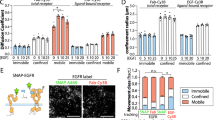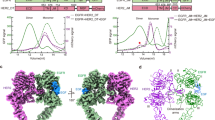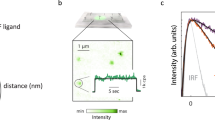Abstract
The erbB/HER family of transmembrane receptor tyrosine kinases (RTKs) mediate cellular responses to epidermal growth factor (EGF) and related ligands. We have imaged the early stages of RTK-dependent signaling in living cells using: (i) stable expression of erbB1/2/3 fused with visible fluorescent proteins (VFPs), (ii) fluorescent quantum dots (QDs) bearing epidermal growth factor (EGF-QD) and (iii) continuous confocal laser scanning microscopy and flow cytometry. Here we demonstrate that EGF-QDs are highly specific and potent in the binding and activation of the EGF receptor (erbB1), being rapidly internalized into endosomes that exhibit active trafficking and extensive fusion. EGF-QDs bound to erbB1 expressed on filopodia revealed a previously unreported mechanism of retrograde transport to the cell body. When erbB2-monomeric yellow fluorescent protein (mYFP) or erbB3-monomeric Citrine (mCitrine) were coexpressed with erbB1, the rates and extent of endocytosis of EGF-QD and the RTK-VFP demonstrated that erbB2 but not erbB3 heterodimerizes with erbB1 after EGF stimulation, thereby modulating EGF-induced signaling. QD-ligands will find widespread use in basic research and biotechnological developments.
This is a preview of subscription content, access via your institution
Access options
Subscribe to this journal
Receive 12 print issues and online access
$209.00 per year
only $17.42 per issue
Buy this article
- Purchase on Springer Link
- Instant access to full article PDF
Prices may be subject to local taxes which are calculated during checkout






Similar content being viewed by others
References
Yarden, Y. & Sliwkowski, M.X. Untangling the ErbB signalling network. Nat. Rev. Mol. Cell Biol. 2, 127–137 (2001).
Jorissen, R.N. et al. Epidermal growth factor receptor: mechanisms of activation and signalling. Exp. Cell Res. 284, 31–53 (2003).
Schlessinger, J. Ligand-induced, receptor-mediated dimerization and activation of EGF receptor. Cell 110, 669–672 (2002).
Gadella, T.W.J. Jr. & Jovin, T.M. Oligomerization of epidermal growth factor receptors on A431 cells studied by time-resolved fluorescence imaging microscopy. A stereochemical model for tyrosine kinase receptor activation. J. Cell Biol. 129, 1543–1558 (1995).
Moriki, T., Maruyama, H. & Maruyama, I.N. Activation of preformed EGF receptor dimers by ligand-induced rotation of the transmembrane domain. J. Mol. Biol. 311, 1011–1026 (2001).
Sako, Y., Minoghchi, S. & Yanagida, T. Single-molecule imaging of EGFR signalling on the surface of living cells. Nat. Cell Biol. 2, 168–172 (2000).
Hynes, N.E., Horsch, K., Olayioye, M.A. & Badache, A. The ErbB receptor tyrosine family as signal integrators. Endocr. Relat. Cancer 8, 151–159 (2001).
Jaiswal, J.K., Mattoussi, H., Mauro, J.M. & Simon, S.M. Long-term multiple color imaging of live cells using quantum dot bioconjugates. Nat. Biotechnol. 21, 47–51 (2003).
Gulliford, T.J., Huang, G.C., Ouyang, X. & Epstein, R.J. Reduced ability of transforming growth factor-alpha to induce EGF receptor heterodimerization and downregulation suggests a mechanism of oncogenic synergy with ErbB2. Oncogene 15, 2219–2223 (1997).
Olayioye, M.A., Beuvink, I., Horsch, K., Daly, J.M. & Hynes, N.E. ErbB receptor-induced activation of stat transcription factors is mediated by Src tyrosine kinases. J. Biol. Chem. 274, 17209–17218 (1999).
Cho, H.S. & Leahy, D.J. Structure of the extracellular region of HER3 reveals an interdomain tether. Science 297, 1330–1333 (2002).
Cho, H.S. et al. Structure of the extracellular region of HER2 alone and in complex with the Herceptin Fab. Nature 421, 756–760 (2003).
Ferguson, K.M. et al. EGF activates its receptor by removing interactions that autoinhibit ectodomain dimerization. Mol. Cell 11, 507–517 (2003).
Garrett, T.P.J. et al. The crystal structure of a truncated ErbB2 ectodomain reveals an active conformation, poised to interact with other ErbB receptors. Mol. Cell 11, 495–505 (2003).
Ogiso, H. et al. Crystal structure of the complex of human epidermal growth factor and receptor extracellular domains. Cell 110, 775–787 (2002).
Nagy, P. et al. Lipid rafts and the local density of ErbB proteins influence the biological role of homo- and heteroassociations of ErbB2. J. Cell Sci. 115, 4251–4262 (2002).
Martin-Fernandez, M., Clarke, D.T., Tobin, M.J., Jones, S.V. & Jones, G.R. Preformed oligomeric epidermal growth factor receptors undergo an ectodomain structure change during signaling. Biophys. J. 82, 2415–2427. (2002).
Lidke, D.S. et al. Imaging molecular interactions in cells by dynamic and static fluorescence anisotropy (rFLIM and emFRET). Biochem. Soc. Trans. 31, 1020–1027 (2003).
Deb, T.B. et al. Epidermal growth factor (EGF) receptor kinase-independent signaling by EGF. J. Biol. Chem. 276, 15554–15560 (2001).
Mendrola, J.M., Berger, M.B., King, M.C. & Lemmon, M.A. The single transmembrane domains of erbB receptors self-associate in cell membranes. J. Biol. Chem. 277, 4704–4712 (2002).
Graus-Porta, D., Beerli, R.R., Daly, J.M. & Hynes, N.E. ErbB-2, the preferred heterodimerization partner of all erbB receptors, is a mediator of lateral signaling. EMBO J. 16, 1647–1655 (1997).
Wang, Z., Zhang, L., Yeung, T.K. & Chen, X. Endocytosis deficiency of epidermal growth factor (EGF) receptor-ErbB2 heterodimers in response to EGF stimulation. Mol. Biol. Cell 10, 1621–1636 (1999).
Wilkinson, J.C. & Staros, J.V. Effect of ErbB2 coexpression on the kinetic interactions of epidermal growth factor with its receptor in intact cells. Biochemistry 41, 8–14 (2002).
Nagy, P., Arndt-Jovin, D. & Jovin, T.M. Small interfering RNAs suppress the expression of endogenous and GFP-fused epidermal growth factor receptor (erbB1) and induce apoptosis in erbB1-overexpressing cells. Exp. Cell Res. 285, 39–49 (2003).
Bridges, A.J. et al. Tyrosine kinase inhibitors. 8. An unusually steep structure-activity relationship for analogues of 4-(3-bromoanilino)-6,7-dimethoxyquinazoline (PD 153035), a potent inhibitor of the epidermal growth factor receptor. J. Med. Chem. 39, 267–276 (1996).
Hasson, T. Myosin VI: two distinct roles in endocytosis. J. Cell Sci. 116, 3453–3461 (2003).
Small, J.V., Stradal, T., Vignal, E. & Rottner, K. The lamellipodium: where motility begins. Trends Cell Biol. 12, 112–120 (2002).
Sliwkowski, M.X. et al. Coexpression of erbB2 and erbB3 proteins reconstitutes a high affinity receptor for heregulin. J. Biol. Chem. 269, 14661–14665 (1994).
Dahan, M. et al. Diffusion dynamics of glycine receptors revealed by single-quantum dot tracking. Science 302, 442–445 (2003).
Brock, R., Hamelers, I.H. & Jovin, T.M. Comparison of fixation protocols for adherent cultured cells applied to a GFP fusion protein of the epidermal growth factor receptor. Cytometry 35, 353–362 (1999).
Zacharias, D.A., Violin, J.D., Newton, A.C. & Tsien, R.Y. Partitioning of lipid-modified monomeric GFPs into membrane microdomains of live cells. Science 296, 913–916 (2002).
Acknowledgements
The project was supported by funding from the Max Planck Gesellschaft, D.S.L., P.N., R.H by the European Union FP5 Project, J.N.P. by a DFG grant to D.J.A.-J., and E.A.J.-E. by CONICET.
Author information
Authors and Affiliations
Corresponding authors
Ethics declarations
Competing interests
The authors declare no competing financial interests.
Supplementary information
41587_2004_BFnbt929_MOESM2_ESM.mov
Supplementary Movie 1. EGF-QD binding and internalization (Fig2a). Time series of CHO cells expressing erbB1-eGFP (green) with addition of 200 pM 6:1 EGF-QD (red). EGF-QD binding and internalization of the erbB1-eGFP-EGF-QD complex is observed. Note that the cell in the upper left corner undergoes cell division during EGF-QD-erbB1-eGFP endocytosis. 4 s/frame, playback 10 frames/s. Resolution: 0.14 -μm x 0.14 μm. (MOV 3952 kb)
41587_2004_BFnbt929_MOESM3_ESM.mov
Supplementary Movie 2. Z-stack projection of EGF-QD activation and internalization (Fig. 2b). Time series of CHO cells expressing erbB1-eGFP (green) with addition of 250 pM 30:1 EGF-QD (red). Ruffling of the cell surface in response to the EGF-QD binding is seen, followed by extensive internalization. Maximum projection of 12 slices to capture whole cell. 1 min/frame, playback 10 frames/s. _x,y,z: 0.14 μm x 0.14 μm x 0.62 μm. (MOV 556 kb)
41587_2004_BFnbt929_MOESM4_ESM.mov
Supplementary Movie 3. Selective internalization of EGF-QD-erbB1 on erbB3-mCitrine expressing cells (Fig. 3a). Time series of an A431 cell expressing erbB3-mCitrine (green) with addition of 200 pM 6:1 EGF-QD (red). EGF-QDs are seen to bind to the filopodia and travel to the cell body, while the erbB3-mCitrine remains on the cell surface. Maximum projection of 4 slices. 4.5 s/frame, playback 10 frames/s. _x,y,z: 0.1 μm x 0.1 μm x 0.5 μm. (MOV 1076 kb)
41587_2004_BFnbt929_MOESM5_ESM.mov
Supplementary Movie 4. ErbB1-eGFP-EGF-QD endosome fusion (Fig. 4). Time series of a CHO cell expressing erbB1-eGFP (green). Series begins 30 min after addition of 200 pM 6:1 EGF-QD (red). Brownian motion, directed movement and fusion of the erbB1-eGFP-EGF-QD endosomes is observed. Maximum projection of 3 slices. 3.6 s/frame, playback 5 frames/s. _x,y,z: 0.14 μm x 0.14 μm x 0.5 μm. (MOV 585 kb)
Rights and permissions
About this article
Cite this article
Lidke, D., Nagy, P., Heintzmann, R. et al. Quantum dot ligands provide new insights into erbB/HER receptor–mediated signal transduction. Nat Biotechnol 22, 198–203 (2004). https://doi.org/10.1038/nbt929
Received:
Accepted:
Published:
Issue Date:
DOI: https://doi.org/10.1038/nbt929
This article is cited by
-
All that Nobel glitters is not biotech gold
Nature Biotechnology (2023)
-
Nanomedicine in therapeutic warfront against estrogen receptor–positive breast cancer
Drug Delivery and Translational Research (2023)
-
High-precision estimation of emitter positions using Bayesian grouping of localizations
Nature Communications (2022)
-
Counting growth factors in single cells with infrared quantum dots to measure discrete stimulation distributions
Nature Communications (2019)
-
Interferometric scattering microscopy reveals microsecond nanoscopic protein motion on a live cell membrane
Nature Photonics (2019)



